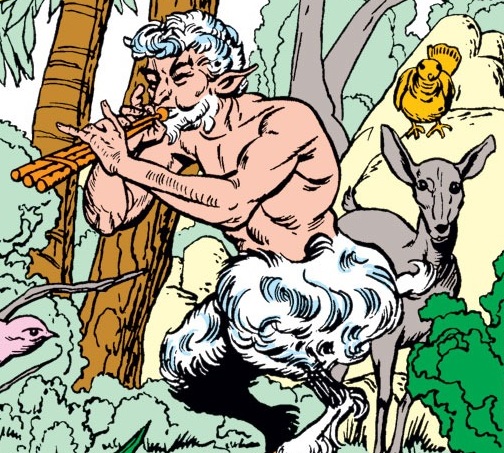
PAN
Real Name: Aegipan
Identity/Class: Extradimensional
(Olympian god)
Occupation: God of
shepherds, flocks and forests; former museum security guard and
innkeeper
Group Membership: Gods
of Olympus
Affiliations: Gods of
Olympus
Enemies: Titans,
Typhon
Known Relatives: Hermes
(father); Dryope (mother, SEE COMMENTS); Abderus, Autolycus,
Hermaphroditus, Silenius (half-brothers); Marsyas and the other Satyrs
(nephews); Zeus
(grandfather); Maia (grandmother); Chiron, Neptune,
Pluto
(great-uncles); Apollo,
Ares, Dionysus,
Hephaestus,
Hercules (uncles); Artemis,
Eileithyia, Eris,
Hebe, Persephone,
Venus
(aunts); Calypso, Demeter,
Hera, Vesta
(great-aunts); Cupid
Aeneas,
Orpheus, Harmonia (cousins)
Aliases: The Goat-God,
Faunus, Sylvanus
Base of Operations: Olympus;
sometimes mobile on Earth, Peloponnesian Arcadia (former)
First Appearance: Tales to
Astonish I#6/3 (November, 1959)
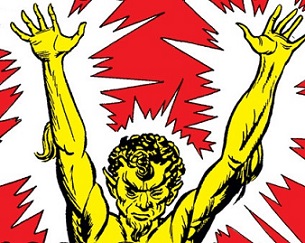
Powers/Abilities: Pan
possesses the conventional attributes of the Olympian gods such as
superhuman strength (possibly Class 15?), longevity, stamina and
resistance to injury. He also has some mystical powers such as the
ability to commit feats of material transformation and possibly to
teleport between Earth and Olympus. He is adept at playing the syrinx
(also called panpipes) and he has a very wily mind and a raucous sense
of humor.
Physical Features: Pan has the hind-quarters of a
goat, pointed ears, and two small horns on his head.
Height: Unrevealed (5' 10"; by approximation)
Weight: Unrevealed
Eyes: Unrevealed
Hair: White
History: (Greek-Roman Myth)
- Pan is the son of Hermes, the god of messengers and thieves. His
mother is generally unrevealed because his appearance so frightened her
that she ran away. Pan lived in the lesser mountains around Olympus,
although he was a patron god of Arcadia. He spent much of his time using
his powers to protect the animals of the forest and pursuing lesser
faerie-like divinities (called nymphs) for sexual favors. He even once
fell in love with the goddess Syrinx. She fled to the protection of her
father, the river-god Ladon, who transformed her into marsh reeds to
conceal her. Unable to tell which one was she, Pan reportedly took some
of the reeds to make his panpipes or else named the one he already owned
after her.
Pan was a staunch defender alongside the Olympian Gods,
and as Zeus conquered Olympus, Pan discovered that his shout could
invoke terror among the Titans in their battle against the Olympians.
His scream was such a source of terror that it became the source of the
word “panic.”
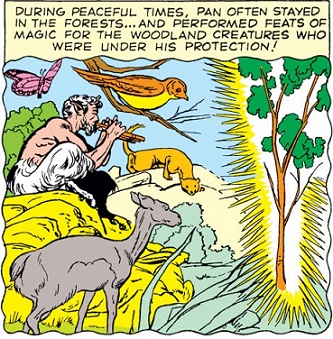
Pan also pursued the moon-goddess Selene and wooed her
attention by showing and promising her a beautiful white fleece. A
favorite companion of Gaea
(Mother Earth), Pan discovered the hiding place of Demeter when she hid
following the abduction of her daughter Persephone. He reported her
location to Zeus, who sent the Fates to convince her to return to
Olympus.
Several generations later, Gaea (upset over the treatment
of the Titans) gave birth to the Giants, and Pan again used his scream
against them. However, Typhon, who preceded the Giants, appeared unfazed
against his screams and wounded Zeus by removing the sinews from his
hands and feet. Pan and Hermes banded together to rescue Zeus and help
him defeat Typhon.
(Greek-Roman Myth, Tales to Astonish I#6/3 (fb)) - Around
490 BC, Pan encountered a runner named Philippides near Mount Parthenius
and asked him why the Athenians did not honor him since he had
befriended them in the past and wished to continue their friendship.
Philippides reported this message to the Athenians as Pan came to their
defense in the Battle of Marathon against the invading Persians shortly
thereafter. Using his shout to invoke terror in their enemies, he used
his magic to transform their weapons into harmless objects such as
plants and fruit and saved the city from invasion. Honoring Pan, the
Athenians consecrated a cave on the north side of the Acropolis to
worship him.
(Tales to Astonish I#6/3 (fb)) - Pan remained fascinated
by mortals, and over the years he assumed mortal disguises in order to
remind mortal man of the grandeur of the Olympian Gods, particularly
himself.
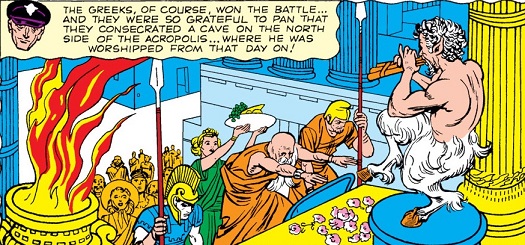
(Tales to Astonish I#6/3) - Posing as an art museum
security guard, Pan overheard a man named Norman criticizing a painting
of Pan to his girlfriend, Diane. Without identifying himself, the
disguised Pan walked over and tried to impress Norman with his history
and feats, but Norman remained unimpressed. Unable to dissuade Norman’s
attitude, he caused Norman's mustache to disappear and his hair to fall
out to the point that it would only resemble a crew-cut.
(Tales to Astonish I#36/3) - A man visited a town amidst
the Swiss Alps, which claimed to be the home of Pan. Taking up lodging
at a local inn, the man hoped to debunk the rumors of Pan's existence.
When everyone in town claimed to have seen Pan at some point, the man
forced a bartender to tell him how to locate Pan. Though he had no luck
searching the woods, he followed a trail of hoof-prints back to his
hotel. The man fled from the town after learning that the innkeeper was
Pan (...or at least that he had cloven hooves instead of feet).
(Journey Into Mystery Annual I#1/1) - During Thor's first
visit to Olympus, he noticed Pan blowing his pipes as he entertained his
fellow gods.
(Bizarre Adventures#29/1 - BTS) - Karras, a satyr
posing as a lawn service specialist, killed and sacrificed homeowner
Harold Parkette to Pan. (see comments)
Comments: Adapted by Stan
Lee, Jack
Kirby and Christopher Rule.
Pan’s parentage is a matter of debate.
Traditionally, he is the son of Hermes, but he has also been called the
son of Zeus and Hybris, Zeus and Aex, Zeus and Boetis, Apollo and Dryope
or the son of Helios. His mother has been variously identified as Iris the
rainbow goddess, Penelope the wife of Odysseus or Penelope, daughter of
King Dryops. Chronologically, since his existence predates both the mortal
candidates for his mother, Iris is the most likely candidate.
The Bizarre Adventures story is
most likely not Earth-616 canon, but has little excepting it from the
fact. The story, "The Lawnmower Man," was written by Stephen King, based
on his short story of the same name. While most of these sorts of tales
are considered outside of continuity, there have been enough included in
such so that this one could be seen to be on the gray edge of such for
now.
I see no reason to leave them out. It's just the
narrow-minded who keep screaming "canon, canon, canon!" If there is
nothing to exclude it, then leave it. The perfect out is to put it in
real time (the time of publication) rather than in the sliding
timescale, which allows the modern era to bypass it.
--Snood..
Tony Randall played Pan (along with a host of other
creatures) in the classic movie, "The
Seven Faces of Doctor Lao" (1964).
Thanks to Snood for covering TTA I#36!
Profile by Will U. Expansion by Ron Fredricks.
CLARIFICATIONS:
Pan is not to be confused with:
- Dionysus -
agent of ISAAC--Captain Marvel I#60
- Marsyas - satyr who encountered King Midas, (Not seen in the
MU)
- Peter Pan, fabled adolescent and leader of the Lost Boys who
never grew up, From the novel by J. M. Barrie
- Panafrika of Earth-15104 (Here Comes Tomorrow)--New X-Men I#153
- Pandara -
servant of Lord Tantalus--Thunderstrike I#4
- Pandarus -
Lycian Commander at the Trojan War--Thor Annual I#8
- Pandemonia -
succubus defeated by X-Force--X-Force I#80
- Pandora -
Ancient Greek sorceress who introduced sin into the world--Journey
Into Mystery I#74
- Pandora - of the Special Executive of the Technet--Captain
Britain II#3
- Pandor of Earth-928 - 2099 AD, Twenty-First Century mutant--X-Men
2099: Oasis#1
- Pandora of Ultraverse - duplicate of Markie created by
Gemini--Mantra I#4
- Panentropic Engine - creature created from bodies of thousands
by Slaymaster--Secret Defenders#20
- Pang - demonic creature spawned by Demogoblin--Marc Spector: Moon Knight#46
- Pangea - game preserve created by extraterrestrials--Ka-Zar
The Savage#1
- Pangora - home planet of the Pangorians--Thor I#387
- Pangorians -
extraterrestrial race encountered by Thor--Thor I#387
- Bobby Pankowicz - Manhattan cop killed at collapse of World
Trade Center--Punisher VI#32
- Colonol Dimitri Panshin - former KGB interrogator--Captain
America/Nick Fury: Blood Truce
- The
Pantheon - advanced organization created by Agamemnon--Incredible Hulk II#368
- Pantheon of Sorcerers - secret cabal of mystics and magicians
on K'ai--Incredible Hulk II#139
- Panther -
Professor Elixir, 19th Century traveling Medicine Man--Two Gun
Kid#77
- Panther -
Corrine, member of STORM and the Gene Dogs--Gene Dogs#1
- Panther God -
African deity who supplies power to Black Panthers--Fantastic Four
I#52
- Panther Guard of Earth-928 - ca. 2099 A.D., Mkhaali, defender of 21st
Century Wakanda--Doom 2099#11
- Panthera -
Earth-Amalgam villainess--Tales of the Amazons#1
- Pantherius - Changeling loyal to Leoninus--Incredible Hulk
II#252
- Panto-9 - home planet of Interstel
Church of Perpetual Annoyance--Lunatik#3
- Panumdrum -
Whurl chancellor robot who served Princess Tallibone--X-Men
Unlimited I#32
- Tanaraq - Great Beast, possessed Sasquatch--X-Men I#120
- Tapio - Finnish forest-god, (Not seen in the MU)
- Woodgod - genetically created satyr, lawgiver of the
Changelings--Marvel Premiere#31
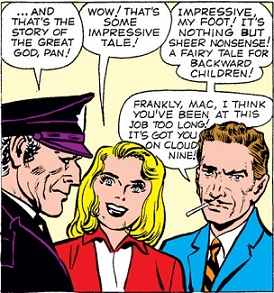
|
Norman and Diane
Norman and Diane (last names unrevealed) were a
couple who went on a date to an art museum -- since he had only known
her for a short while, Norman wanted to impress Diane by posing as an
art critic.
As they looked over various paintings on display, Norman
made disparaging remarks about the artwork, but when he saw a painting
of the Greek god Pan, he openly ridiculed it ("Whoever dreamed that
one up must've had rocks in his head! It looks like some clown's
poster for National Billy Goat Week!").
Norman's comment was overheard by a museum security guard,
who advised him that he shouldn't belittle Pan, and he told Norman and
Diane about Pan's history and feats. But Norman was still unimpressed.
As the couple left the museum, the guard warned Norman that he would
soon learn not to scoff at things which he did not understand.
Two weeks later, when Norman and Diane next saw each
other, Diane noticed that Norman seemed to have shaved off his mustache
(his pride and joy); but Norman told her that it had just disappeared
one night, then he removed his had and showed her that the hair on his
head wouldn't grow any longer than a crew-cut.
As they drove off in his car, Norman told Diane that he
never should have mocked the guard's story of Pan. Then Norman mentioned
that as they left the museum that day, he had turned around to take one
last look at the painting of Pan, and he happened to see the guard
walking away -- Norman didn't want to say anything to Diane at the time,
because he didn't want her to think he was "batty," but it looked like
the guard had a pair of cloven hooves instead of feet!
--Tales to Astonish I#6/3
|
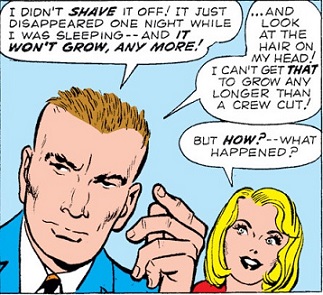
|
images: (without ads)
Tales to Astonish I#6/3, p1, pan4 (Main Image - Pan, as depicted in museum painting)
Tales to Astonish I#6/3, p3, pan3 (Headshot - Pan)
Tales to Astonish I#6/3, p3, pan1 (Pan among woodland creatures)
Tales to Astonish I#6/3, p3, pan5 (security guard relates how Pan was worshiped by Greeks)
Tales to Astonish I#6/3, p4, pan1 (Diane and Norman; security guard (left))
Tales to Astonish I#6/3, p4, pan4 (Norman with his crew-cut hair and missing mustache; Diane)
Appearances:
Tales to Astonish I#6/3 (November, 1959) - Stan Lee (plot/editor), Larry Lieber (script), Jack Kirby (pencils), Christopher Rule (inks), Stan Goldberg (colors), Artie Simek (letters)
Tales to Astonish I#36/3 (October 1962) - Stan Lee (writer/editor), Steve Ditko (pencils/inks), Stan Goldberg (colors), Artie Simek (letters)
Journey into Mystery Annual I#1 (1965) - Stan Lee (writer/editor), Jack Kirby (pencils), Vince Colletta (inks), Stan Goldberg (colors), Sam Rosen (letters)
Bizarre Adventures#29 (December 1981) - Stephen King (writer), Walt Simonson (artist), Denny O'Neil (editor)
First posted: 06/08/2004
Last updated: 10/10/2022
Any Additions/Corrections? please let me know.
Non-Marvel
Copyright info
All other characters mentioned or pictured are ™ and © 1941-2099
Marvel Characters, Inc. All Rights Reserved. If you like this stuff, you
should check out the real thing!
Please visit The Marvel Official Site at: http://www.marvel.com
Special Thanks to
www.g-mart.com for hosting the Appendix, Master List, etc.!
Back
to Characters





